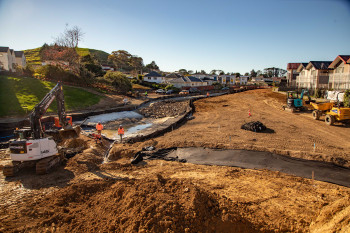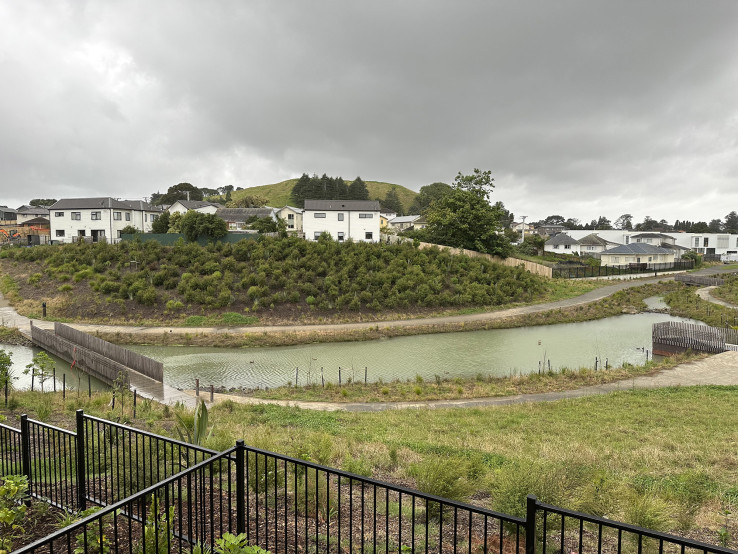Building climate resilient homes and communities
We recognise the importance of building homes and communities that are resilient to our changing climate.
Innovative urban design, integrated nature-based approaches, and significant infrastructure upgrades are just some of the ways we are increasing the resilience and environmental sustainability of Kāinga Ora developments throughout Aotearoa New Zealand.
We work closely with local and central Government, mana whenua, our build and development partners and the community to deliver high-quality urban developments that will not only benefit communities today, but in generations to come.
As New Zealand’s climate changes, we know that some of our customers and homes are likely to be impacted by climate change induced events. All our significant projects go through a climate change risk assessment during planning; this includes exposure and vulnerability to flooding, and mitigating actions for all highly rated risks. We’re balancing the need to build at pace, with the need to build wisely.
We are also actively working to improve our environmental data to help mitigate climate risk to our homes, tenants and future investments. This data supports our ongoing development of strategy, policy, governance and operational responses to climate risks, ensuring we can respond quickly and effectively in a weather event.
Assessing and mitigating climate risks in our developments
In our large-scale projects, thorough investigations of all climate-affected natural hazards impacting on potential development sites, including overland flow paths and floodplains, are completed as part of obtaining approvals from our local authority partners. This work includes land surveys, stormwater modelling, and designs to mitigate against flooding events. We work closely with local authorities to identify suitable locations for stormwater management devices such as detention ponds, to help alleviate flooding and assess whether water can be treated before it goes out into waterways.
Our smaller scale projects are also subject to the same type of investigations alongside local authority partners. This ensures that as much of our work as possible, right down to the individual dwelling, makes valuable contributions to minimising and avoiding the impacts of climate-affected natural hazards.
Since June 2022 all significant Kāinga Ora projects undertake a climate change risk assessment during planning. This includes assessing exposure and vulnerability to flooding, and mitigating actions for all highly rated risks.
Building resilience through infrastructure
 Working with our civil and infrastructure partners, we design and construct new and upgraded infrastructure to support our large-scale urban development projects.
Working with our civil and infrastructure partners, we design and construct new and upgraded infrastructure to support our large-scale urban development projects.
Before building even starts, one of our first tasks is to consider how we can improve the capacity, quality and resilience of the infrastructure in the area, to ensure it can support the community’s current and future needs. This work differs by development and location, but could include:
- upgrading stormwater and wastewater networks to prevent overflows into backyards, parks and waterways
- undergrounding power and telecommunication lines to protect them from severe weather events
- upgrading reserves and green spaces to increase wetland capacity and improve stormwater retention
We ensure all infrastructure works for our urban development projects meet council requirements before beginning construction of new homes.
Case Study
We were pleased to see the positive difference our urban development work made to communities that would have otherwise been badly damaged by the Auckland flooding event in January 2023.
Designed to cater for a 1-in-100-year weather event (which the rainfall exceeded), new stormwater solutions in our Northcote, Mt Roskill and Ōwairaka large-scale developments functioned exactly as expected, diverting huge amounts of water away from homes and draining it away in a safe and controlled way.
A good example is Greenslade Reserve in our Northcote Development. This reserve is not only a sports ground and park for the community, but also a stormwater retention basin. During the floods it filled up, containing the vast majority of the floodwaters, and by the next morning, all the surface water had drained so families could return to playing on the grass.
A collaboration with local mana whenua, Auckland Council and council organisations, this infrastructure is a crucial component of the thriving communities we are developing, supporting the resilience and environmental sustainability we will need long into the future.
Watch: Our civil alliance partner helping us with this work, Piritahi, has a great video explaining the effect the recent floods had on our developments: https://lnkd.in/gg9pSmVP(external link)
Read more: Greenslade Reserve does its job in Auckland’s floods » Northcote Development(external link)
Putting sustainability at the core of our developments
Our Hobsonville Point development is an example of how careful planning and innovative urban design can help achieve environmentally sustainable outcomes. Water management in particular was a key focus when planning out this area, to minimise impact on the nearby harbour. Homes were built with rainwater tanks to help reduce the amount of stormwater entering the system. Rain gardens and bio-retention swales were designed, and more than 10,000 native trees planted, to pre-treat road run-off.
Watch: How Innovative Urban Design is Safeguarding Water Quality at Hobsonville Point
Nature-based urban design
Our developments often include upgraded reserves, waterways and green spaces to increase wetland capacity and improve stormwater retention or detention.
A key example is the recently opened Freeland Reserve in our Mt Roskill development, which was previously an area prone to flooding. Working in partnership with mana whenua, Auckland Council, Piritahi and the community, the previously piped Oakley Creek/Te Auaunga Awa was daylighted and returned to its natural state. The reserve’s wetland capacity was also increased with over 100 native trees and close to 8,000 plants, in addition to three new floodwalls to contain flooding.
Not only did this upgrade provide a scenic and welcoming space for the community, it allowed for a much greater level of flood management. In Auckland’s floods of January 2023 we saw this in action, as the reserve contained floodwaters and directed it down overland flow paths to protect neighbouring properties.
Read more:
- Celebrating the opening of Freeland Reserve in Roskill South(external link)
- Restoration of Te Auaunga Awa helps transform Roskill into a greener, healthier, more connected suburb(external link)


Freeland Reserve during and after the Auckland flooding event in January 2023. The reserve contained floodwaters and directed it down overland flow paths to protect neighbouring properties.
Page updated: 28 May 2025
